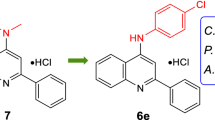Abstract
A few halo, nitro and methoxy substituted 1:2-naphthoquinones with the substituents in both the benzenoid and the quinonoid rings have been synthesised and evaluated for their fungistatic properties. Among the quinonoid compounds tested 3:4-dichloro-1:2-naphthoquinones exhibited the highest activity.
Similar content being viewed by others
References
Baichwal, R. S. and Khorana, M. L.J. Sci. and Ind. Res., 1952,11 A, 197.
Babu Rao, K. and Subba Rao, N. V. Ibid., 1958,17 B, 225.
Fieser, L. F. and Dunn, J. T.J. Am. Chem. Soc., 1937,59, 1016.
Sen, R. N. and Sen, B. K.J. Ind. Chem. Soc., 1934,11, 411.
Zincke, Th...Ber., 1886,19, 2493.
Fries, K. and Schmmelschmidt, K.Ann., 1930,484, 245.
Schoene, D. L., Tate, H. D. and Brasfield, T. W.Agr. Chemicals, 1949,4, 25
Author information
Authors and Affiliations
Rights and permissions
About this article
Cite this article
Marinath Babu, B., Subba Rao, N.V. Search for physiologically active compounds. Proc. Indian Acad. Sci. 66, 301–305 (1967). https://doi.org/10.1007/BF03049338
Received:
Issue Date:
DOI: https://doi.org/10.1007/BF03049338




